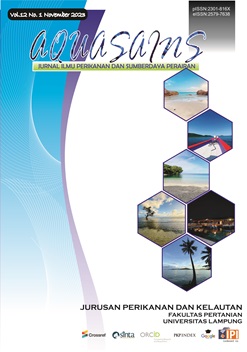ANALYSIS OF THE TROPHIC STATUS OF THE BABON RIVER, SEMARANG
DOI:
https://doi.org/10.23960/aqs.v13i1.p1589-1595 Abstract View: 152
Abstract View: 152
Abstract
The Babon River watershed, located in Semarang, Central Java, is an important resource for the local community in their daily activities. Effective river management is essential to maintain the surrounding ecosystem. This research aimed to provide information on the trophic status and water quality of the Babon River. Sampling was conducted in November 2021 and January 2022 using a purposive sampling method. The trophic state index (TSI) was used to assess water fertility, with measurements focusing on variables such as brightness, total phosphate, and chlorophyll-a. Additional parameters supporting water quality assessment included nitrate, dissolved oxygen (DO), pH, discharge, current velocity, and water temperature. The results indicated that the parameters measured were still within the standards for class II and III river water quality as outlined in Government Regulation (PP) No. 22 of 2021. Multiple linear regression analysis revealed non-simultaneous effects of nutrients (nitrate and total phosphate) on chlorophyll-a content, with a determination value of 21.3%. This suggests that low nutrient levels influence the presence of chlorophyll-a in the waters, while the remaining 78.7% of chlorophyll-a variability is attributed to other factors.
Keywords: Babon River, chlorophyll-a, nitrate, trophic state index, total phosphate.
Downloads
References
Adani, N. G., Muskanonfola, M. R., & Hendrarto, I. B. (2013). Kesuburan perairan ditinjau dari kandungan klorofil-a fitoplankton studi kasus di Sungai Wedung, Demak. Management of Aquatic Resources Journal, 2(4), 38- 45.
American Public Health Association (APHA). (2005). Standard Methods for the Examination of Water and Wastewater. 21th ed. American Public Health. Washington DC.
Carlson, R.E. (1977). A trophic state index for lake. Limnology and Oceanography, 22(2), 361-369.
Djoharam, V., Riani, E., & Yani, M. (2018). Analisis kualitas air dan daya tampung beban pencemaran Sungai Pesanggrahan di wilayah Provinsi DKI Jakarta. Jurnal Pengelolaan Sumberdaya Alam dan Lingkungan, 8(1), 127-133.
Effendi, H. (2003). Telaah Kualitas Air bagi Pengelolaan Sumber Daya dan Lingkungan Perairan. Kanisius. Yogyakarta. 258 hlm.
Khalifa, M. A., & Indaryato, F. R. (2018). Tingkat kesuburan perairan Daerah Aliran Sungai (DAS) Cibanten. Jurnal Perikanan dan Kelautan, 8(2), 163-169.
Khasani, A., Afiati, N., & Sulardiono, B. (2017). Analisis trophic state index Carlson air muara Sungai Banjir Kanal Timur, Semarang. Management of Aquatic Resources Journal, 6(1), 17-25.
Kospa, H. S. D., & Rahmadi. (2019). Pengaruh perilaku masyarakat terhadap kualitas air di Sungai Sekanak Kota Palembang. Jurnal Ilmu Lingkungan, 17(2), 212 – 221.
Patty, S. I., Rizqi, M. P., & Huwae, R. (2022). Dissolved oxygen in the East Bolaang Mongondow Waters, North Sulawesi. Jurnal Ilmiah PLATAX, 10(1), 216-223.
Peraturan Gubernur Jawa Tengah Nomor 2 Tahun 2017 tentang Peruntukan Air dan Pengelolaan Kualitas Air Sungai Babon di Provinsi Jawa Tengah.
Peraturan Pemerintah Republik Indonesia No. 22 Tahun 2021 tentang Penyelenggaran Perlindungan dan Pengelolaan Lingkungan Hidup.
Raymond, M., Yanuar, M. J. P., Hartoyo, S., Sapei, A., & Wayan, I. A. (2011). Analisis keberlanjutan pengelolaan air baku DAS Babon (studi kasus di Kota Semarang). Jurnal Rekayasa Lingkungan, 7(2), 193-204.
Sugiyono. (2011). Metode Penelitian Kuantitatif, Kuantitatif dan R&D. Alfabeta. Bandung.
Wijayanto, A. P. W., Purnomo, & Suryanti. (2015). Analisis kesuburan perairan berdasarkan bahan organik total, nitrat, fosfat dan klorofil-a di Sungai Jajar Kabupaten Demak. Management of Aquatic Resources Journal, 4(3), 76-83.
Yanti, E. V. (2017). Dinamika musiman kualitas air di daerah Sungai Kahayan Kalimantan Tengah. Ziraa'ah Majalah Ilmiah Pertanian, 42(2), 107-118.
Yulis, P. A. R., Desti, A. F., & Febliza, A. (2018). Analisis kadar DO, BOD, dan COD air sungai kuantan terdampak penambangan emas tanpa izin. Jurnal Bioterdidik: Wahana Ekspresi Ilmiah, 6(3), 1-11.
Yunita, N. F., Agam, B., Maryono, & Merdekawati, D. (2021). Analisa parameter kimia perairan di Danau Kurapan dan Sungai Sambas Desa Sepantai, Kabupatern Sambas. Berkala Perikanan Terubuk, 49(1), 741-747.
Downloads
Published
How to Cite
Issue
Section
License
License for Authors
Authors who publish with this journal agree to the following terms:
- Authors retain copyright and grant the journal right of first publication with the work simultaneously licensed under a Creative Commons Attribution License that allows others to share the work with an acknowledgement of the work's authorship and initial publication in this journal.
- Authors are able to enter into separate, additional contractual arrangements for the non-exclusive distribution of the journal's published version of the work (e.g., post it to an institutional repository or publish it in a book), with an acknowledgement of its initial publication in this journal.
- When the article is accepted for publication, its copyright is transferred to Aquasains Journal. The copyright transfer convers the exclusive right to reproduce and distribute the article, including offprint, translation, photographic reproduction, microfilm, electronic material, (offline or online) or any other reproduction of similar nature.
- Authors are permitted and encouraged to post their work online (e.g., in institutional repositories or on their website) prior to and during the submission process, as it can lead to productive exchanges, as well as earlier and greater citation of published work (See The Effect of Open Access).
- The Author warrant that this article is original and that the author has full power to publish. The author sign for and accepts responsibility for releasing this material on behalf os any and all-author. If the article based on or part os student’s thesis, the student needs to sign as his/her agreement that his/her works is going published.
License for Regular Users
Other regular users who want to cite, distribute, remix, tweak, and build upon author’s works, even for commercial purposes, should acknowledge the work’s authorship and initial publication in this journal, licensed under a Creative Commons Attribution License.
This license lets others distribute, remix, tweak, and build upon your work, even commercially, as long as they credit you for the original creation.
This work is licensed under a Creative Commons Attribution 4.0 International License.Copyright Transfer Statement can be downloaded here


.png)









